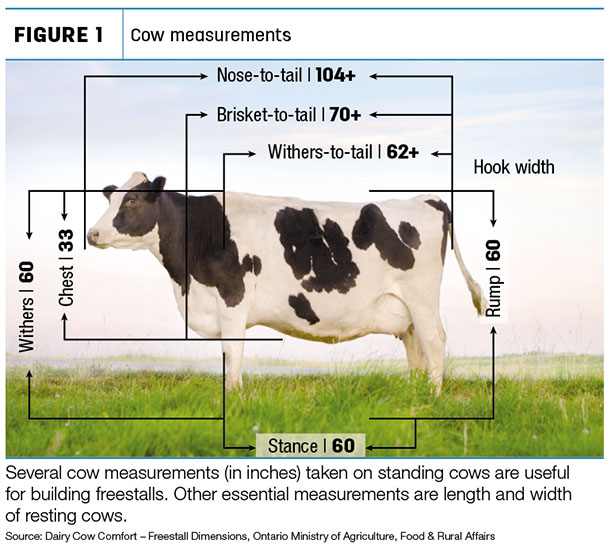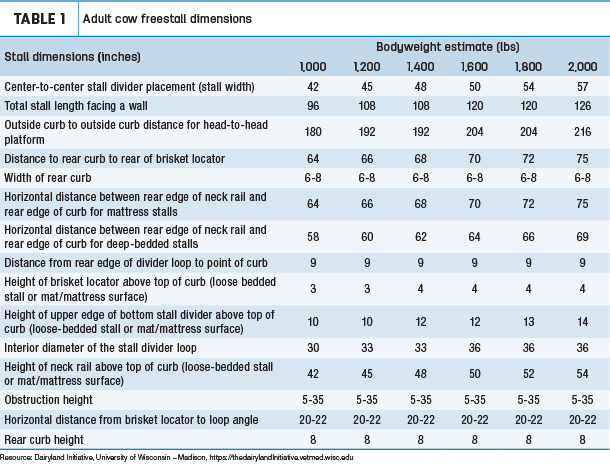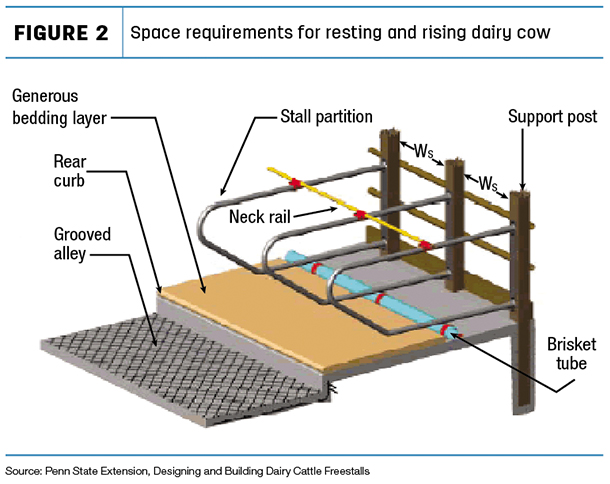This is important because dairy cows spend 12 to 14 hours a day lying down. Ensuring they have adequate space and comfort for lying leads to healthier, cleaner cows producing higher-quality milk.
That said, evaluating stall dimensions and design characteristics is a critical step toward improving cow comfort.
Features of cow comfort include:
- Stock density of greater than 120 percent leads to a competition of resources and reduced lying times, lameness, reduced rumination and milk yield. (There is no benefit to understocking freestall pens.)
- Free movement without being jostled and shoved by other cows
- Minimizing regrouping and moves between groups
- Easy, continuous access to fresh feed and water
- Clean, dry, well-bedded resting area
- Plenty of space in freestalls or on a bedded pack to recline and rise
- Enough stalls or bedded pack space to always have a place to lie down (Overstocking results in an increased number of cows standing idly in the alley waiting for stalls. When resting or lying time is lost, it may take cows up to 40 hours to recoup the lost resting time. More than likely, if cows are competing for space in stalls, they are competing for space at the feedbunk.)
- Confident, slip-free flooring
- Plenty of fresh, dry air
- Dry, draft-free conditions in the winter
- Shady, breezy locations during hot weather
Ask these benchmark questions to address cow comfort:
- Monitor how frequently cows are lying in a stall
- Measure how long cows lie in stalls
- How many lame cows are in each pen? How severe is the lameness?
- What is your stocking density?
- Do cows stand in the stall versus lie down?
- Do cows stand two feet in the stall and two feet in the alley?
- How dirty are the cows?
- Monitor the dirtiness and wetness of the stalls
- How often are the stalls cleaned?
- Is your bulk tank somatic cell count too high?
- What is your culling rate and why?
- What is the size of my cows? Do the largest cows fit in the stall – width and length?
These questions provide a baseline for your cows’ current comfort. After determining your baseline, set goals and make changes to improve cows’ comfort in stalls.
Stalls
Freestalls should provide a place for cows to:
- Lie down comfortably and rest up to 14 hours per day
- Promote cow and udder cleanliness
- Allow for more efficient rumination
- Prevent injuries
A comfortable stall encourages resting and accommodates reasonable rates of heat loss. Freestall dimensions for a group of dairy cows depends on the size of the cows and tolerance of the farmer or laborer for tending manure-contaminated stalls. Freestalls should be sized to provide the largest 25 percent of cows in a group with a comfortable place to rest. The largest cow in the herd should be able to enter the stall, lie down, rest comfortably, and easily get to her feet and exit the stall. You can determine cow size by taking measurements of standing and lying cows. Figure 1 illustrates which measures are useful when evaluating stall size.

There are several important dimensions to consider when evaluating freestalls. (See Table 1 for specific recommendations based on cow size.) Figure 2 illustrates the different components of the freestall discussed below.

Freestall length should be about 8 to 12 feet. This stall length will provide adequate lunge space allowing the cow to lunge forward and rise naturally. Typical lunge space for a mature Holstein cow is 3 to 4 feet beyond the resting space. Shorter freestalls require an opening at the front of the stall to allow a cow to thrust her head through as she rises. If forward lunge space is not possible, modify the stall to allow the cow to lunge to the side through the partition. Note: Side lunging is not normal cow behavior and can reduce stall usage. When fully risen, the cow should be able to stand with all four feet in the stall and her head under the neck rail completely. If cows are standing perched two feet in and two feet out of the stall or with their head above the neck rail, adjustments may be needed to the stall structure.

Stall width should aim to prevent disturbances between neighboring cows and facilitate rising and lying. Stall width will vary from 42 inches for a 1,000-pound cow to 57 inches for a 2,000-pound cow. Excessively wide stalls allow smaller cows to lie at an angle that allows defecation in the stall.
Freestall partitions should guide the cow into the stall, help position the cow and provide protection from cows in adjacent stalls. Lower divider rails should include a 5-inch space between the lower edge of the lower divider rail and the top of the brisket locator. This allows cows to work legs free if they should get stuck.
The freestall curb separates the stall area from manure in the cow alley. The curb should be high enough to prevent manure from entering the stall but low enough to allow cows to enter and exit the stall easily. Maximum recommended height is 8 inches. If mattresses or mats are used, the maximum height from alley to stall is 7 inches.
The role of the brisket board or locator is to help position the cow as she lies down. The brisket locator should not interfere with the cow lunging or resting comfort. A brisket locator 4 to 6 inches high defines the available body space on the stall bed and discourages forward movement of resting cows.
The neck rail discourages cows from moving too far forward when entering the stall to provide adequate lunge space for rising and reclining. The neck rail is one of the most important pieces to position the cow properly. Properly positioned neck rails allow the largest cows to stand on the stall surface with all four legs and the top of her neck gently touching the neck rail. It encourages cows to step back as she rises to exit the stall. The neck rail is often positioned too near the curb to make sure the stall stays clean; however, this decreases stall usage. Neck rails should be fixed, not free to move up and down.
Bent or broken stall components should be repaired and/or replaced before they become an obstacle to stall use, cow well-being or cause injury.
Diagonal lying
Stalls will stay cleaner if we encourage cows to lie straight in the stall. For cows to lie straight, we must provide cows with a space to have all four legs in the stall. Occasionally, cows may lie diagonally in stalls.
Diagonal lying may be caused by stalls:
- Being too short
- Having forward lunge space obstructions such as a traverse stall divider mounting bars and deterrent bars, which are between the stall surface and 38 inches above the surface
- Having brisket locators higher than 4 inches above the stall surface
- Having brisket locators placed too near the curb, restricting lying space
- Are very wide for the size of cows in the barn or pen
As you evaluate cow comfort, ask yourself, “What is their current comfort level and how can I improve?” The goals you set for improvement of cow comfort will determine how aggressive you need to be with changes to stalls. ![]()
Staff photo.

-
Kim Clark
- Dairy Extension Educator
- University of Nebraska – Lincoln
- Email Kim Clark







